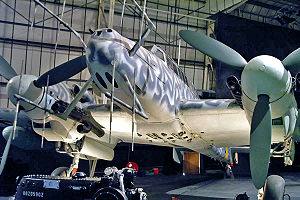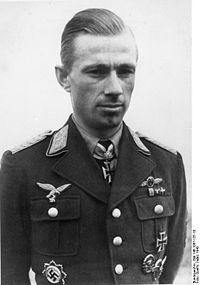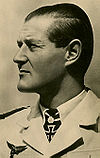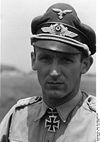
List of German World War II Night Fighter aces
Encyclopedia

Military aviation
Military aviation is the use of aircraft and other flying machines for the purposes of conducting or enabling warfare, including national airlift capacity to provide logistical supply to forces stationed in a theater or along a front. Air power includes the national means of conducting such...
credited with shooting down five or more enemy aircraft
Aircraft
An aircraft is a vehicle that is able to fly by gaining support from the air, or, in general, the atmosphere of a planet. An aircraft counters the force of gravity by using either static lift or by using the dynamic lift of an airfoil, or in a few cases the downward thrust from jet engines.Although...
during aerial combat. German day and night fighter pilots claimed roughly 70,000 aerial victories during World War II, 25,000 over British or American and 45,000 over Russian flown aircraft. 103 German fighter pilots shot down more than 100 enemy aircraft for a total of roughly 15,400 aerial victories. Roughly a further 360 pilots claimed between 40 and 100 aerial victories for round about 21,000 victories. Another 500 fighter pilots claimed between 20 and 40 victories for a total of 15,000 victories. It is relatively certain that 2,500 German fighter pilots attained ace status, having achieved at least 5 aerial victories. These achievements were honored with 453 German day and Zerstörer (destroyer) pilots having received the Knight's Cross of the Iron Cross
Knight's Cross of the Iron Cross
The Knight's Cross of the Iron Cross was a grade of the 1939 version of the 1813 created Iron Cross . The Knight's Cross of the Iron Cross was the highest award of Germany to recognize extreme battlefield bravery or successful military leadership during World War II...
. 85 night fighter pilots, including 14 crew members, were awarded the Knight's Cross of the Iron Cross. The list is sorted by the number of aerial victories claimed at night.
German night fighter aces
| Name | Rank | Night Victories | Day Victories | Total Wartime Victories | | Unit | | Notes | | Picture |
|---|---|---|---|---|---|---|---|
| Major | 121 | 0 | 121 | NJG 1, NJG 4 | |||
| * | Oberst | 102 | 8 | 110 | ZG 76, NJG 1, NJG 2, NJG 3 | killed in flying accident 7 October 1944 |  |
| style="background:#e3d9ff;" align="left" | * | Major | 83 | 0 | 83 | NJG 2 | killed in action Killed in action Killed in action is a casualty classification generally used by militaries to describe the deaths of their own forces at the hands of hostile forces. The United States Department of Defense, for example, says that those declared KIA need not have fired their weapons but have been killed due to... 21 January 1944 |
|
| Oberst | 67 | 1 | 68 | ZG 1, NJG 1 | |||
| * | Hauptmann | 65 | 0 | 65 | NJG 1, NJG 5 | killed in action Killed in action Killed in action is a casualty classification generally used by militaries to describe the deaths of their own forces at the hands of hostile forces. The United States Department of Defense, for example, says that those declared KIA need not have fired their weapons but have been killed due to... 21 January 1944 |
 |
| Oberst | 64 | 1 | 65 | ZG 1, NJG 1, NJG 3, NJG 2 |  |
||
| Major | 64 | 0 | 64 | NJG 1, NJG 2, NJG 3, NJG 100, NJGr 10, NJG 5 | |||
| Hauptmann | 63 | 1 | 64 | NJG 2 |  |
||
| Major | 59 | 0 | 59 | NJG 2, NJG 3, NJG 100, NJG 5 | |||
| Hauptmann | 58 | 0 | 58 | NJG 4, NJG 6 | |||
| Hauptmann | 58 | 0 | 58 | NJG 3, NJG 2 | |||
| Major | 57 | 16 | 73 | ZG 76, NJG 3, NJG 1, NJG 4, JV 44 JV 44 Jagdverband 44 was a special fighter unit of top German fighter ace pilots in the Luftwaffe during the last months of World War II. The main aircraft used by the unit was the Messerschmitt Me 262 jet fighter... |
|||
| Oberleutnant | 56 | 7 | 63 | JG 301, Kdo Welter, NJG 11 | |||
| Oberleutnant | 56 | 0 | 56 | NJG 100 | |||
| Hauptmann | 56 | 0 | 56 | NJG 4, NJG 5, NJG 6, NJG 1 | |||
| style="background:#e3d9ff;" align="left" | * | Hauptmann | 56 | 0 | 56 | ZG 26, NJG 2, NJG 1 | killed in action Killed in action Killed in action is a casualty classification generally used by militaries to describe the deaths of their own forces at the hands of hostile forces. The United States Department of Defense, for example, says that those declared KIA need not have fired their weapons but have been killed due to... 25 December 1944 |
|
| * | Hauptmann | 55 | 0 | 55 | ZG 1, NJG 1 | killed in action Killed in action Killed in action is a casualty classification generally used by militaries to describe the deaths of their own forces at the hands of hostile forces. The United States Department of Defense, for example, says that those declared KIA need not have fired their weapons but have been killed due to... 27 September 1943 |
|
| * | Oberfeldwebel | 54 | 0 | 54 | NJG 1 | killed in action Killed in action Killed in action is a casualty classification generally used by militaries to describe the deaths of their own forces at the hands of hostile forces. The United States Department of Defense, for example, says that those declared KIA need not have fired their weapons but have been killed due to... 26 February 1944 |
|
| * | Hauptmann | 53 | 0 | 53 | NJG 1 | killed in action Killed in action Killed in action is a casualty classification generally used by militaries to describe the deaths of their own forces at the hands of hostile forces. The United States Department of Defense, for example, says that those declared KIA need not have fired their weapons but have been killed due to... 29 September 1943 |
|
| * | Major | 51 | 0 | 51 | ZG 76, NJG 1, NJG 2, NJG 5 | Killed in flying accident 22 March 1944 | |
| Major | 50 | 1 | 51 | ZG 52, ZG 2, NJG 3, NJG 5 | |||
| Stabsfeldwebel | 49 | 0 | 49 | NJG 1, NJG 4 | |||
| Hauptmann | 47 | 4 | 51 | NJG 1 | |||
| Oberstleutnant | 47 | 3 | 50 | NJG 1, NJG 6 |  |
||
| Hauptmann | 47 | 1 | 48 | NJG 1 | |||
| * | Oberleutnant | 46 | 2 | 48 | ZG 1, NJG 1 | killed in action Killed in action Killed in action is a casualty classification generally used by militaries to describe the deaths of their own forces at the hands of hostile forces. The United States Department of Defense, for example, says that those declared KIA need not have fired their weapons but have been killed due to... 24 February 1943 |
|
| * | Hauptmann | 46 | 0 | 46 | NJG 1 | killed in action Killed in action Killed in action is a casualty classification generally used by militaries to describe the deaths of their own forces at the hands of hostile forces. The United States Department of Defense, for example, says that those declared KIA need not have fired their weapons but have been killed due to... 6 December 1944 |
|
| * | Hauptmann | 46 | 0 | 46 | NJG 1 | killed in action Killed in action Killed in action is a casualty classification generally used by militaries to describe the deaths of their own forces at the hands of hostile forces. The United States Department of Defense, for example, says that those declared KIA need not have fired their weapons but have been killed due to... 26 February 1943 |
|
| * | Major | 46 | 0 | 46 | NJG 2 | killed in action Killed in action Killed in action is a casualty classification generally used by militaries to describe the deaths of their own forces at the hands of hostile forces. The United States Department of Defense, for example, says that those declared KIA need not have fired their weapons but have been killed due to... 8 February 1945 |
 |
| Hauptmann | 45 | 2 | 47 | ZG 2, NJG 1, NJG 5 | |||
| Leutnant | 45 | 0 | 45 | NJG 3 | |||
| * | Major | 45 | 0 | 45 | NJG 2, NJG 100 | missing in action Missing in action Missing in action is a casualty Category assigned under the Status of Missing to armed services personnel who are reported missing during active service. They may have been killed, wounded, become a prisoner of war, or deserted. If deceased, neither their remains nor grave can be positively... 23 February 1944 |
|
| * | Hauptmann | 44 | 0 | 44 | ZG 1, NJG 1 | killed in action Killed in action Killed in action is a casualty classification generally used by militaries to describe the deaths of their own forces at the hands of hostile forces. The United States Department of Defense, for example, says that those declared KIA need not have fired their weapons but have been killed due to... 3 February 1943 |
|
| * | Oberstleutnant | 43 | 16 | 59 | NJG 5 | killed in action Killed in action Killed in action is a casualty classification generally used by militaries to describe the deaths of their own forces at the hands of hostile forces. The United States Department of Defense, for example, says that those declared KIA need not have fired their weapons but have been killed due to... 6 March 1945 |
 |
| Major | 43 | 6 | 49 | ZG 76, NJG 1 | |||
| Hauptmann | 43 | 0 | 43 | NJG 1 | |||
| Hauptmann | 41 | 0 | 41 | NJG 1 | |||
| Hauptmann | 39 | 2 | 41 | NJG 1, NJG 5, NJG 6 | |||
| Hauptmann | 38 | 1 | 39 | NJG 1, NJG 4 | |||
| Major | 37 | 2 | 39 | NJG 1, NJG 102 | |||
| Major | 35 | 4 | 39 | ZG 1, NJG 1 | |||
| Oberleutnant | 38 | 0 | 38 | NJG 2, NJG 1, NJG 3 | |||
| Hauptmann | 36 | 0 | 36 | NJG 4, NJG 1 | |||
| Oberleutnant | 35 | 0 | 35 | NJG 100 | |||
| Oberfeldwebel | 34 | 3 | 37 | SKG 210, NJG 4, NJG 6 | |||
| Hauptmann | 34 | 0 | 34 | NJG 2 | |||
| Major | 34 | 0 | 34 | NJG 1, NJG 3 | |||
| Hauptmann | 34 | 0 | 34 | NJG 1, NJG 5, NJG 6 | |||
| Hauptmann | 34 | 0 | 34 | NJG 1 | |||
| * | Major | 33 | 0 | 33 | NJG 4, NJG 6 | killed in action Killed in action Killed in action is a casualty classification generally used by militaries to describe the deaths of their own forces at the hands of hostile forces. The United States Department of Defense, for example, says that those declared KIA need not have fired their weapons but have been killed due to... 16 March 1945 |
|
| Hauptmann | 33 | 0 | 33 | NJG 1, NJG 4, NJG 6, NJGr 10 | |||
| Oberfeldwebel | 33 | 0 | 33 | ZG 76, SKG 210, 10(NJ)/ZG 1 | |||
| * | Oberfeldwebel | 33 | 0 | 33 | NJG 1 | killed in action Killed in action Killed in action is a casualty classification generally used by militaries to describe the deaths of their own forces at the hands of hostile forces. The United States Department of Defense, for example, says that those declared KIA need not have fired their weapons but have been killed due to... 21 July 1944 |
|
| Major | 31 | 0 | 31 | NJG 1, NJG 4 | |||
| Hauptmann | 30 | 0 | 30 | NJG 2, NJG 3 | |||
| Major | 30 | 0 | 30 | NJG 3, NJG 1, NJG 5 | missing in action Missing in action Missing in action is a casualty Category assigned under the Status of Missing to armed services personnel who are reported missing during active service. They may have been killed, wounded, become a prisoner of war, or deserted. If deceased, neither their remains nor grave can be positively... 5 March 1945 |
||
| Major | 30 | 0 | 30 | JG 300, NJGr 10 | |||
| * | Hauptmann | 28 | 1 | 29 | NJG 1, NJG 5, NJG 3 | killed in action Killed in action Killed in action is a casualty classification generally used by militaries to describe the deaths of their own forces at the hands of hostile forces. The United States Department of Defense, for example, says that those declared KIA need not have fired their weapons but have been killed due to... 2 January 1944 |
|
| Oberstleutnant | 28 | 22 | 50 | ZG 76, NJG 1 |  |
||
| * | Hauptmann | 26 | 2 | 28 | NJG 1 | killed in action Killed in action Killed in action is a casualty classification generally used by militaries to describe the deaths of their own forces at the hands of hostile forces. The United States Department of Defense, for example, says that those declared KIA need not have fired their weapons but have been killed due to... 4 October 1943 |
|
| * | Leutnant | 26 | 1 | 27 | NJG 1 | Died of wounds 13 October 1943 | |
| * | Hauptmann | 25 | 1 | 26 | NJG 1, NJG 2, NJG 3 | killed in action Killed in action Killed in action is a casualty classification generally used by militaries to describe the deaths of their own forces at the hands of hostile forces. The United States Department of Defense, for example, says that those declared KIA need not have fired their weapons but have been killed due to... 6 January 1945 |
|
| * | Oberleutnant | 24 | 3 | 27 | ZG 76, NJG 1, NJG 2 | killed in action Killed in action Killed in action is a casualty classification generally used by militaries to describe the deaths of their own forces at the hands of hostile forces. The United States Department of Defense, for example, says that those declared KIA need not have fired their weapons but have been killed due to... 14 May 1943 |
|
| Oberstleutnant | 24 | 0 | 24 | NJG 1, NJG 2, NJG 4 | |||
| * | Oberleutnant | 16 | 8 | 24 | ZG 141, ZG 76, NJG 1 | killed in action Killed in action Killed in action is a casualty classification generally used by militaries to describe the deaths of their own forces at the hands of hostile forces. The United States Department of Defense, for example, says that those declared KIA need not have fired their weapons but have been killed due to... 2 June 1942 |

